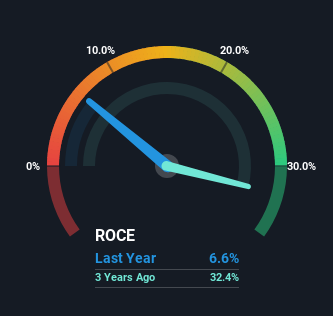- Hong Kong
- /
- Basic Materials
- /
- SEHK:691
There Are Reasons To Feel Uneasy About China Shanshui Cement Group's (HKG:691) Returns On Capital
If you're looking for a multi-bagger, there's a few things to keep an eye out for. Firstly, we'll want to see a proven return on capital employed (ROCE) that is increasing, and secondly, an expanding base of capital employed. This shows us that it's a compounding machine, able to continually reinvest its earnings back into the business and generate higher returns. However, after briefly looking over the numbers, we don't think China Shanshui Cement Group (HKG:691) has the makings of a multi-bagger going forward, but let's have a look at why that may be.
Understanding Return On Capital Employed (ROCE)
If you haven't worked with ROCE before, it measures the 'return' (pre-tax profit) a company generates from capital employed in its business. The formula for this calculation on China Shanshui Cement Group is:
Return on Capital Employed = Earnings Before Interest and Tax (EBIT) ÷ (Total Assets - Current Liabilities)
0.066 = CN¥1.4b ÷ (CN¥33b - CN¥12b) (Based on the trailing twelve months to June 2023).
Thus, China Shanshui Cement Group has an ROCE of 6.6%. On its own that's a low return, but compared to the average of 4.2% generated by the Basic Materials industry, it's much better.
See our latest analysis for China Shanshui Cement Group

Historical performance is a great place to start when researching a stock so above you can see the gauge for China Shanshui Cement Group's ROCE against it's prior returns. If you'd like to look at how China Shanshui Cement Group has performed in the past in other metrics, you can view this free graph of past earnings, revenue and cash flow.
How Are Returns Trending?
When we looked at the ROCE trend at China Shanshui Cement Group, we didn't gain much confidence. Around five years ago the returns on capital were 53%, but since then they've fallen to 6.6%. Given the business is employing more capital while revenue has slipped, this is a bit concerning. This could mean that the business is losing its competitive advantage or market share, because while more money is being put into ventures, it's actually producing a lower return - "less bang for their buck" per se.
On a side note, China Shanshui Cement Group has done well to pay down its current liabilities to 37% of total assets. That could partly explain why the ROCE has dropped. Effectively this means their suppliers or short-term creditors are funding less of the business, which reduces some elements of risk. Some would claim this reduces the business' efficiency at generating ROCE since it is now funding more of the operations with its own money.
The Bottom Line On China Shanshui Cement Group's ROCE
We're a bit apprehensive about China Shanshui Cement Group because despite more capital being deployed in the business, returns on that capital and sales have both fallen. This could explain why the stock has sunk a total of 71% in the last five years. That being the case, unless the underlying trends revert to a more positive trajectory, we'd consider looking elsewhere.
If you'd like to know more about China Shanshui Cement Group, we've spotted 3 warning signs, and 1 of them can't be ignored.
While China Shanshui Cement Group isn't earning the highest return, check out this free list of companies that are earning high returns on equity with solid balance sheets.
New: AI Stock Screener & Alerts
Our new AI Stock Screener scans the market every day to uncover opportunities.
• Dividend Powerhouses (3%+ Yield)
• Undervalued Small Caps with Insider Buying
• High growth Tech and AI Companies
Or build your own from over 50 metrics.
Have feedback on this article? Concerned about the content? Get in touch with us directly. Alternatively, email editorial-team (at) simplywallst.com.
This article by Simply Wall St is general in nature. We provide commentary based on historical data and analyst forecasts only using an unbiased methodology and our articles are not intended to be financial advice. It does not constitute a recommendation to buy or sell any stock, and does not take account of your objectives, or your financial situation. We aim to bring you long-term focused analysis driven by fundamental data. Note that our analysis may not factor in the latest price-sensitive company announcements or qualitative material. Simply Wall St has no position in any stocks mentioned.
About SEHK:691
China Shanshui Cement Group
An investment holding company, engages in the manufacture and sale of cement, clinker, concrete, and related products and services in the People’s Republic of China.
Adequate balance sheet with very low risk.
Market Insights
Community Narratives



